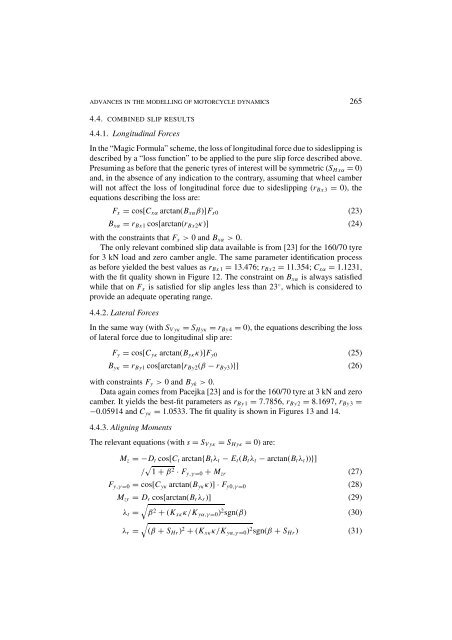Advances in the Modelling of Motorcycle Dynamics - ResearchGate
Advances in the Modelling of Motorcycle Dynamics - ResearchGate
Advances in the Modelling of Motorcycle Dynamics - ResearchGate
You also want an ePaper? Increase the reach of your titles
YUMPU automatically turns print PDFs into web optimized ePapers that Google loves.
ADVANCES IN THE MODELLING OF MOTORCYCLE DYNAMICS 2654.4. COMBINED SLIP RESULTS4.4.1. Longitud<strong>in</strong>al ForcesIn <strong>the</strong> “Magic Formula” scheme, <strong>the</strong> loss <strong>of</strong> longitud<strong>in</strong>al force due to sideslipp<strong>in</strong>g isdescribed by a “loss function” to be applied to <strong>the</strong> pure slip force described above.Presum<strong>in</strong>g as before that <strong>the</strong> generic tyres <strong>of</strong> <strong>in</strong>terest will be symmetric (S Hxα = 0)and, <strong>in</strong> <strong>the</strong> absence <strong>of</strong> any <strong>in</strong>dication to <strong>the</strong> contrary, assum<strong>in</strong>g that wheel camberwill not affect <strong>the</strong> loss <strong>of</strong> longitud<strong>in</strong>al force due to sideslipp<strong>in</strong>g (r Bx3 = 0), <strong>the</strong>equations describ<strong>in</strong>g <strong>the</strong> loss are:F x = cos[C xα arctan(B xα β)]F x0 (23)B xα = r Bx1 cos[arctan(r Bx2 κ)] (24)with <strong>the</strong> constra<strong>in</strong>ts that F x > 0 and B xα > 0.The only relevant comb<strong>in</strong>ed slip data available is from [23] for <strong>the</strong> 160/70 tyrefor 3 kN load and zero camber angle. The same parameter identification processas before yielded <strong>the</strong> best values as r Bx1 = 13.476; r Bx2 = 11.354; C xα = 1.1231,with <strong>the</strong> fit quality shown <strong>in</strong> Figure 12. The constra<strong>in</strong>t on B xα is always satisfiedwhile that on F x is satisfied for slip angles less than 23 ◦ , which is considered toprovide an adequate operat<strong>in</strong>g range.4.4.2. Lateral ForcesIn <strong>the</strong> same way (with S Vyκ = S Hyκ = r By4 = 0), <strong>the</strong> equations describ<strong>in</strong>g <strong>the</strong> loss<strong>of</strong> lateral force due to longitud<strong>in</strong>al slip are:F y = cos[C yκ arctan(B yκ κ)]F y0 (25)B yκ = r By1 cos[arctan{r By2 (β − r By3 )}] (26)with constra<strong>in</strong>ts F y > 0 and B yk > 0.Data aga<strong>in</strong> comes from Pacejka [23] and is for <strong>the</strong> 160/70 tyre at 3 kN and zerocamber. It yields <strong>the</strong> best-fit parameters as r By1 = 7.7856, r By2 = 8.1697, r By3 =−0.05914 and C yκ = 1.0533. The fit quality is shown <strong>in</strong> Figures 13 and 14.4.4.3. Align<strong>in</strong>g MomentsThe relevant equations (with s = S Vyκ = S Hyκ = 0) are:M z =−D t cos[C t arctan{B t λ t − E t (B t λ t − arctan(B t λ t ))}]/ √ 1 + β 2 · F y,γ =0 + M zr (27)F y,γ =0 = cos[C yκ arctan(B yκ κ)] · F y0,γ =0 (28)M zr = D r cos[arctan(B r λ r )]√(29)λ t = β 2 + (K xκ κ/K yα,γ =0 ) 2 sgn(β) (30)√λ r = (β + S Hr ) 2 + (K xκ κ/K yα,γ =0 ) 2 sgn(β + S Hr ) (31)
















